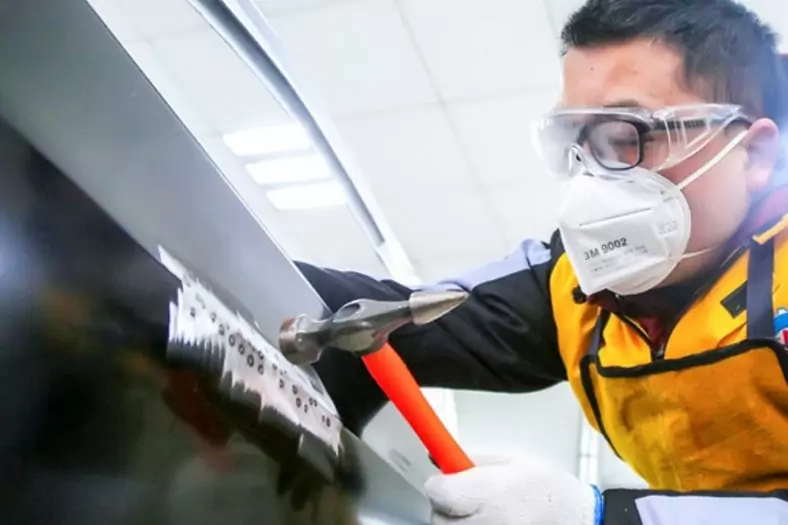
Computer Numerical Control (CNC) machine tools have become the backbone of modern manufacturing industries, enabling efficient and precise production of complex components and products.
The accuracy and reliability of CNC machines play a crucial role in ensuring the quality of the final output. Geometric accuracy inspection is a fundamental aspect of maintaining CNC machine tools, as it involves evaluating and verifying the machine’s positioning, straightness, flatness, squareness, parallelism, and circularity.
In this article, we will explore the importance of geometric accuracy inspection, the key parameters involved, the inspection process, and the benefits it offers in optimizing CNC machining processes.
Understanding Geometric Accuracy
1.What is Geometric Accuracy?
Geometric accuracy refers to the ability of a CNC machine to consistently achieve precise movements and positions according to specified tolerances. It ensures that the tool’s actual movement closely matches the intended path, resulting in accurate and repeatable machining.
2.Importance of Geometric Accuracy
Geometric accuracy is critical for achieving high-quality manufacturing results. When CNC machines maintain geometric accuracy, it reduces errors and ensures consistent part dimensions, leading to minimal scrap, reduced rework, and higher productivity.
3.Key Parameters of Geometric Accuracy
- Positioning Accuracy: The ability of the machine to place the tool or workpiece at a specific location within a designated tolerance.
- Straightness: The deviation of the machine’s motion from a perfectly straight path.
- Flatness: The degree to which a surface is perfectly flat without any waviness or curvature.
- Squareness: The perpendicularity between two surfaces or axis of motion.
- Parallelism: The degree of alignment between two surfaces or axis of motion, ensuring they are equidistant from each other along their length.
- Circularity: The deviation of a circular path from a perfect circle.
Importance of Geometric Accuracy Inspection
1.Quality Assurance
Geometric accuracy inspection is essential for maintaining consistent quality in manufactured parts. By verifying the machine’s performance, manufacturers can ensure that the produced components meet precise specifications, preventing defects and non-conforming products.
2.Optimizing Manufacturing Processes
Accurate geometric inspection helps identify any deviations or errors in the machine’s operation. By addressing these issues promptly, manufacturers can optimize machining processes, reduce cycle times, and increase overall production efficiency.
3.Long-Term Cost Savings
Regular geometric accuracy inspection allows early detection of potential problems or wear in the machine’s components. Timely maintenance and calibration can prevent costly breakdowns, reducing downtime and extending the CNC machine’s lifespan.
Methods for Geometric Accuracy Inspection
1.Precision Measuring Instruments
Various precision measuring instruments are used for geometric accuracy inspection, such as:
- Laser Interferometers: Measures linear and angular displacement with high accuracy.
- Coordinate Measuring Machines (CMMs): Determines the 3D coordinates of points on the machined surface.
- Dial Indicators: Provides accurate linear measurements.
2.Machine Calibration
Calibration is an integral part of geometric accuracy inspection. It involves adjusting the CNC machine’s components to align with the specified geometrical parameters.
Geometric Accuracy Inspection Process
1.Pre-Inspection Preparation
- Cleaning and preparing the machine surfaces for accurate measurements.
- Ensuring proper fixturing and alignment for inspection.
2.Taking Measurements
- Following a step-by-step procedure for conducting geometric accuracy inspection.
- Recording and analyzing measurement data.
3.Interpreting Results
- Evaluating measurement data to identify any deviations from specified geometric parameters.
- Understanding tolerances and determining whether adjustments are required.
Benefits of Regular Geometric Accuracy Inspection
1.Preventing Machine Deterioration
Regular inspections help identify early signs of wear or misalignment in the CNC machine’s components, allowing for timely corrective actions to maintain optimal performance.
2.Reducing Downtime
By conducting regular inspections and addressing potential issues promptly, manufacturers can minimize unplanned downtime and schedule maintenance during planned maintenance periods.
3.Enhancing Customer Satisfaction
Consistently delivering high-quality products with precise dimensions enhances customer satisfaction and builds a reputation for reliability and precision.
Geometric accuracy inspection is a fundamental process for maintaining CNC machine tools and ensuring the quality and precision of manufactured components. It plays a crucial role in quality assurance, optimizing manufacturing processes, and reducing long-term operational costs. By utilizing precision measuring instruments and following proper inspection procedures, manufacturers can identify and address geometric errors, maintaining the CNC machine’s accuracy and efficiency. Regular inspections and calibration contribute to the longevity of CNC machines, reduce downtime, and enhance customer satisfaction, ultimately solidifying a company’s position in the competitive world of modern manufacturing. As technology advances and industries evolve, the focus on geometric accuracy inspection remains integral to achieving consistent and high-quality results in CNC machining.
At present, the commonly used testing tools for testing the geometric accuracy of machine tools in China are: precision level, square ruler, precision square box, flat ruler, collimator, dial indicator or micrometer, high-precision spindle mandrel and some rigid Sub-table rods, etc. The specific detection method of each geometrical accuracy shall be stipulated by the detection conditions of the machine tool. However, the accuracy level of the inspection tool must be one level higher than the measured geometric accuracy. For example, a flat ruler is used to check the parallelism of the X-axis movement to the worktable, and the table difference is required to be within 0.025/750mm!
At Be-cu.com,we use advanced equipment to offer you Unparalleled precision for producing metal and plastic machining parts
- We combine the latest CNC milling and turning processes with proprietary technology to deliver high quality, on-demand parts.
- Our team of engineers and machinists program the equipment to optimize cutting time, surface finish, and final tolerance to meet your design specifications
- We specialize in cnc precision machining, single part prototyping, short to medium production runs, manufacture parts on time, every time, so you can stay ahead of schedule
- CNC machining can create very similar parts to series parts. It is often more efficient and faster than other rapid prototyping technologies for the manufacture of a quantity of prototypes between 1 and 10 parts . We also recommend CNC machining for parts with large sizes (greater than 600 mm).
Contact Us ([email protected]) Now for your Custom CNC Machining, We are your best online cnc machining and rapid prototyping services choice!
